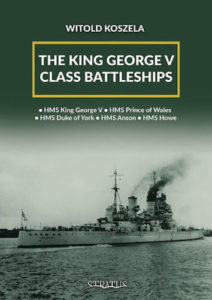 The story of the Royal Navy during World War II often centers around one of the five battleships of the King George V Class (KGV): HMS King George V, HMS Prince of Wales, HMS Duke of York, HMS Anson, and HMS Howe. The author of this book has crafted a tour de force that examines in detail the KGV class. He examines the internal and external political situations that led to the design of the KGV class, how the KGV design evolved over time, and how the KGV construction progressed. He closes the book with an account of the history of each of the five battleships. Three interesting sub stories within the book are why the KGVs were armed with 14-inch guns, the political turmoil of the naming of the individual ships, and how one almost became a U.S. Navy warship.
The story of the Royal Navy during World War II often centers around one of the five battleships of the King George V Class (KGV): HMS King George V, HMS Prince of Wales, HMS Duke of York, HMS Anson, and HMS Howe. The author of this book has crafted a tour de force that examines in detail the KGV class. He examines the internal and external political situations that led to the design of the KGV class, how the KGV design evolved over time, and how the KGV construction progressed. He closes the book with an account of the history of each of the five battleships. Three interesting sub stories within the book are why the KGVs were armed with 14-inch guns, the political turmoil of the naming of the individual ships, and how one almost became a U.S. Navy warship.
The author starts his account of the KGVs by examining in some detail various components of the ship. One topic he spends considerable time exploring is the armament of these ships. Each type of gun carried by the KGVs is discussed to include technical details and when mounted and removed from the ship. As might be expected, the 14-inch main battery is discussed in great detail. There is also a lengthy discussion of the various search and fire control radars mounted on these ships. All of this discussion is supported by excellent charts that highlight the technical aspects of the equipment being examined.
The book is packed with technical drawings. These drawings include views of the internal subdivision of the ship and the function of each level of the conning tower. Additional drawings show the profile and overhead views of each of the five ships during various periods of their careers. There are also individual drawings of various topside fittings: guns, boats, and aircraft. These drawings are supported by various colored drawings showing the various paint schemes these ships carried during their lifetime. Unfortunately, the last paint scheme carried by Prince of Wales is not provided. In addition, the book is full of clear, sharp photographs of each of the ships. These photos bring life to the text, allowing the reader to form a mental view of the scene being discussed. The book closes with the author providing a comprehensive operational history of each of the five ships of the KGV Class. All had interesting careers seeing duty in the Atlantic, Arctic, Indian and Pacific Oceans plus the Mediterranean Sea. A KGV battleship was present at almost all of the Royal Navy’s noteworthy World War II convoy operations, assault landings, ship to ship engagements, and air operations. Overall, four of the five KGV battleships lived lives which saw them sailing in harms way but suffering little damage or casualties. The exception to this was Prince of Wales who would, in her two encounters with the enemy, suffer far more casualties than she inflicted on the enemy. The author has seen fit to include color photographs of Prince of Wales’ damaged propeller shaft.
If you are interested in battleship design and service life, this book is a must purchase. It will appeal to both the naval historian and the modeler. The price of the book, while high, is very reasonable for the quality of the material it covers. One caveat is that all measurements in the text and charts are in metric.
The King George V Class Battleships
By Witold Koszela, Casemate Publishing, Havertown, PA, (2019).
Charles H. Bogart. Charles is a frequent contributor to Naval History Book Reviews.
Click here to buy The King George V Class Battleships now!

